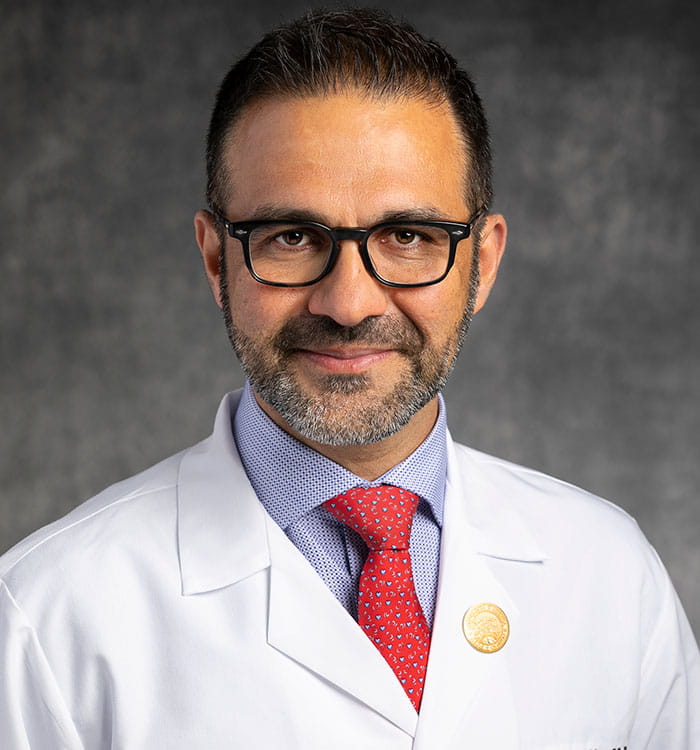Quality Initiative at UH Harrington Heart & Vascular Institute Saves the Limbs of 75 Percent of Patients Slated for Amputation
February 14, 2023
UH Clinical Update | February 2023
An innovative panel within UH Harrington Heart & Vascular Institute is breaking down long-standing barriers between specialties, departments and divisions, dramatically improving outcomes for some of the highest-stakes patients UH treats - those scheduled for major amputation of a limb.
 Mehdi Shishehbor, DO, MPH, PhD
Mehdi Shishehbor, DO, MPH, PhDThe multidisciplinary Limb Salvage Advisory Council (LSAC), initiated by Mehdi Shishehbor, DO, MPH, PhD, President of UH Harrington Heart & Vascular Institute and the Angela and James Hambrick Chair in Innovation, engages diverse medical experts from across UH to thoroughly review and discuss each patient slated for amputation – quickly and in real-time. Vascular surgeons, endovascular interventionalists, vascular medicine specialists, podiatrists and wound care experts all participate.
“Our interdisciplinary LSAC is unique as it involves not just multiple teams, including endovascular interventionalists and vascular surgeons, but often multi-physicians within the same specialty,” Dr. Shishehbor says. “Every patient deserves at least a second and even a third revascularization attempt using various approaches and sometimes different skill sets to save his or her limb. Usually when hospitals have these programs, it’s between vascular surgery and podiatry or cardiology and podiatry. You never have vascular surgery, interventional cardiology, vascular medicine and plastic surgery, all in one group. I have not seen anything like this in the United States.”
Eventually, the LSAC reaches one of two conclusions: the patient’s limb can be salvaged and the team creates a plan to do so, or the panel recommends the originally scheduled amputation.
Stunning Results
Results published in 2022 show that this innovative approach to quality is working. A study published in Circulation: Cardiovascular Interventions reveals that the LSAC at UH saved the limbs of about 75 percent of the people they worked on – a first in the field.
“This is the first study investigating the impact of a novel and proactive interdisciplinary intervention, LSAC, on patients already planned for a major amputation due to critical limb-threatening ischemia (CLTI),” Dr. Shishehbor says. “Excluding those who died or were lost to follow-up, only one-quarter of the patients formerly scheduled for a major amputation and managed by the LSAC actually lost a limb at 180 days, with remarkable wound healing results.”
Overcoming Challenges to Implementation
Dr. Shishehbor says the existing culture of healthcare still unfortunately limits the number of truly multidisciplinary initiatives like the LSAC.
“The practice of medicine is still specialty-, department- and division-centric,” he says. “But today, with many advances, there’s significant overlap of what each specialty, department and division does. As a result, it’s often not very patient-centric for a patient to be treated by one physician, one department or one division. It may be okay for 50 or 60 of diagnoses that are very straightforward, but for conditions where you're going to lose your leg, we believe that we need to have a patient-centric discussion. That requires breaking barriers across specialties, departments and divisions, which means checking our ego at the door, working together, bringing in different experts to work on the patient and coming up with the most ideal and the best treatment. That still doesn't happen that often in medicine because of turf wars of a political nature. But we are working to break down those barriers across multiple areas. The Limb Salvage Advisory Council is a very nice example of that.”
Continuous Improvement
Dr. Shishehbor says there are still areas for improvement with the LSAC. It currently gets activated by a referring physician in only about 40 percent of patients scheduled for major amputation, so creating more awareness within the physician community at UH is key. He and the team also are looking at ways to move the LSAC discussion earlier in a patient’s disease process – when limb-saving treatments are more likely to be effective.
“Is it possible to move this upstream when a patient comes in with an ulcer or gangrene before they undergo multiple surgeries and procedures and bypass?” he says. “At that time, can we activate the LSAC and decide on the best treatment, so that these patients don't go through more treatment for six months, one year, sometimes two years before they see us?”
The precedent for this approach, he says, is tumor board, where the multidisciplinary team is engaged at the beginning of a patient’s cancer care. The intervention of the LSAC currently comes much later in a patient’s CLTI disease process, when disease has progressed so far that amputation is imminent.
For now, Dr. Shishehbor encourages his colleagues to take advantage of the unique services the LSAC provides to UH patients. For patients facing amputation, the stakes couldn’t be higher.
“At UH Harrington Heart & Vascular Institute, we have made a commitment to save every limb that we can,” he says. “Activating the LSAC is a crucial part of that.”


